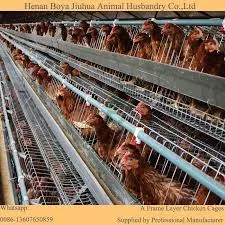Innovative Poultry Cage Systems for Modern Farming Practices and Enhanced Animal Welfare
11 月 . 27, 2024 20:17 Back to list
Innovative Poultry Cage Systems for Modern Farming Practices and Enhanced Animal Welfare
The Rise of Automatic Poultry Cages Revolutionizing Poultry Farming
In recent years, the poultry industry has seen a significant transformation due to technological advancements. One of the most impactful innovations is the introduction of automatic poultry cages. These systems are designed to optimize the rearing process, enhance efficiency, and improve animal welfare, thereby revolutionizing traditional poultry farming. This article explores the benefits, features, and future prospects of automatic poultry cages.
Enhancing Efficiency
Automatic poultry cages allow for a higher degree of efficiency compared to conventional farming methods. With the capacity to house thousands of birds in a compact space, these systems enable farmers to manage larger flocks without drastically increasing labor costs. Automatic feeding and watering systems ensure that each bird receives the right amount of nutrients and hydration at the optimal times. This not only maximizes feed conversion rates but also decreases waste — a crucial aspect for maintaining environmental sustainability.
Moreover, due to the automated nature of these systems, farmers can monitor various parameters such as temperature, humidity, and ventilation in real-time. This data-driven approach facilitates proactive management of the flock's health, further ensuring optimal growth conditions. As a result, farmers experience faster growth rates and improved productivity, leading to higher profits.
Improving Animal Welfare
Automatic poultry cages are designed with animal welfare in mind. Traditional cages often result in overcrowding and limited movement, leading to stress and health issues among the birds. In contrast, modern automatic systems often provide better space management, allowing for more room for each bird while maintaining efficient flock density.
Furthermore, these systems typically feature better environmental controls, such as temperature regulation and air circulation, which creates a more comfortable living environment for the chickens. Health monitoring technologies can detect signs of sickness early, allowing for timely intervention. By prioritizing animal welfare, automatic poultry cages not only ensure happier and healthier birds but also comply with increasingly stringent regulations regarding animal husbandry.
Streamlining Labor Requirements
Labor shortages have long been a challenge in the agriculture sector, and poultry farming is no exception. Automatic poultry cages significantly reduce the need for manual labor, allowing farmers to focus on critical decision-making tasks instead of routine chores. Tasks such as feeding, watering, and waste management are largely automated, freeing up time for farmers to invest in flock health monitoring, strategic planning, and business growth.
automatic poultry cage

This automation alleviates the burden on farm workers, making it easier to manage larger operations with fewer staff
. As labor costs continue to rise and skill shortages become more prevalent, automatic poultry cages present a practical solution that ensures continued productivity and profitability.Environmental Sustainability
As the world faces increasing pressure to adopt sustainable agricultural practices, automatic poultry cages can play a vital role. These systems are inherently designed for resource efficiency. By optimizing feed usage and minimizing waste through controlled feeding schedules, automatic poultry cages reduce the overall environmental impact of poultry farming.
Moreover, waste management systems integrated within these cages facilitate effective collection and treatment of manure, transforming potential pollutants into valuable resources, such as fertilizers for crop production. This closed-loop approach enhances the overall sustainability of poultry farming.
Future Prospects
The future of poultry farming lies in the integration of advanced technologies and automation. With the increasing adoption of artificial intelligence and machine learning, automatic poultry cages are expected to become even more sophisticated. These innovations may include smart sensors that provide real-time health diagnostics and predictive analytics for flock management.
As global demand for poultry products continues to rise, the role of automatic poultry cages will be critical in meeting this demand sustainably and efficiently. Farmers who adopt these technologies will likely gain a competitive edge in a fast-evolving market.
Conclusion
In conclusion, automatic poultry cages offer a multifaceted solution to many of the challenges faced by the poultry industry today. By enhancing efficiency, improving animal welfare, streamlining labor requirements, and promoting environmental sustainability, these systems are transforming poultry farming for the better. As technology continues to advance, it is essential for farmers to embrace these innovations to ensure the future viability of the poultry sector, ultimately benefiting both producers and consumers alike.
-
school
NewsJul.10,2025
-
Vacuum Packing Machine - Efficient & Reliable Vacuum Packaging Solutions for Food & Industrial Use
NewsJun.10,2025
-
High-Quality European Rabbit Cage Durable Welded Rabbit Cage Wire Mesh Supplier
NewsJun.10,2025
-
High-Efficiency Air Inlet Window for Optimal Poultry Ventilation & Cooling
NewsMay.30,2025
-
High-Efficiency Evaporative Cooling Pads Durable & Energy-Saving
NewsMay.30,2025
-
Automatic Egg Collecting Machine High-Efficiency Poultry Farm Solutions
NewsMay.29,2025






